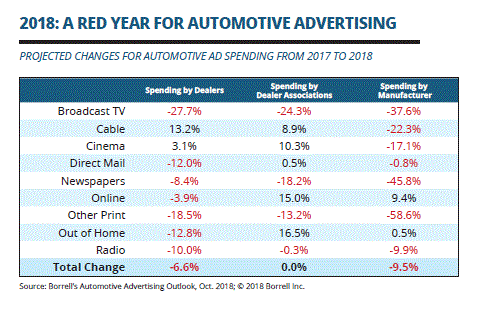Borrell Associates has just released its annual assessment of the $34.4 billion Automotive Advertising category. “For 2018, we’re seeing a lot of red for just about every type of media,” Gordon Borrell notes.
How do things look for 2019? We’ve checked out the report and have some of the answers to share.
The report, with the ominous title “AUTOMOTIVE ADVERTISING TAKES A SHARP TURN,” pulls no punches.
“It’s been a tough year for automotive advertising,” Gordon Borrell notes in the opening paragraph. “For the sellers, especially broadcast TV, the bottom seems to have dropped out.”
For the buyers, “the cutbacks reflect lower new-car sales, flat used-car sales and greater cost efficiency in targeted marketing.”
It’s not that dealers are spending less on marketing. Rather, Borrell says, “They’re just spending less on advertising.”
In fact, marketing budgets are swelling, particularly for digital “services” that help them manage their own direct-to-consumer media channels in social media, email, and their dealer websites.
The result is particularly troublesome for radio, and downright alarming for broadcast television.

Total automotive ad spending this year is down 7.3%, to $34.4 billion.
For 2019, Borrell is forecasting a bounceback of 3.4%. But, Borrell laments, “2019 seems a long way off, especially for companies that still have their 2018 fourth-quarter numbers to hit.”
Then, there’s Borrell’s five-year outlook: Expect “low growth,” averaging 1.7% per year.
Correction: Expect it if you are in digital media, as nearly all of it goes to digital advertising.
Why?
“It’s all the result of fundamental changes brought on by the Great Recession a decade ago,” Borrell surmises.” That economic trigger forced manufacturers and dealers to rethink marketing expenditures and align them with what potential car buyers were doing and where they could be found. As a result, 67% of all automotive advertising now goes to highly targeted digital media, stealing from traditional print and broadcast channels that are considered less efficient.”
Further complicating matters is the fact that dealers are now spending 41% less to advertise a new car than they were five years ago.
“It’s gone from $888 in 2012 to $518 this year,” Borrell writes. “It’s now easier to hit a specific target, which means dealers can be more efficient with their ad buys.”
While “Mass” media still plays a role in branding messages, that’s now being challenged as video advertising migrates to the digital environment.
The new report has led Borrell Associates to recast its numbers to provide a picture of what automotive advertising might look like in 2023.
“These reborn forecasts point to striking changes in future spending,” Gordon Borrell says.
The new model predicts that, five years from now:
• Broadcast TV advertising will be significantly lower
• Radio advertising will be lower
• Cable advertising will be higher
• Digital advertising will be significantly higher
• Print advertising will be significantly lower than 2018 levels
“All of this points to a very different marketing landscape for the automotive industry by 2023,” Borrell concludes. “The advertising piece of overall marketing expenditures is likely to remain in the $35 billion-$37 billion range, but marketing services are likely to get far more attention as manufacturers and dealers spend more time and money on their ‘owned media’ channels.”





